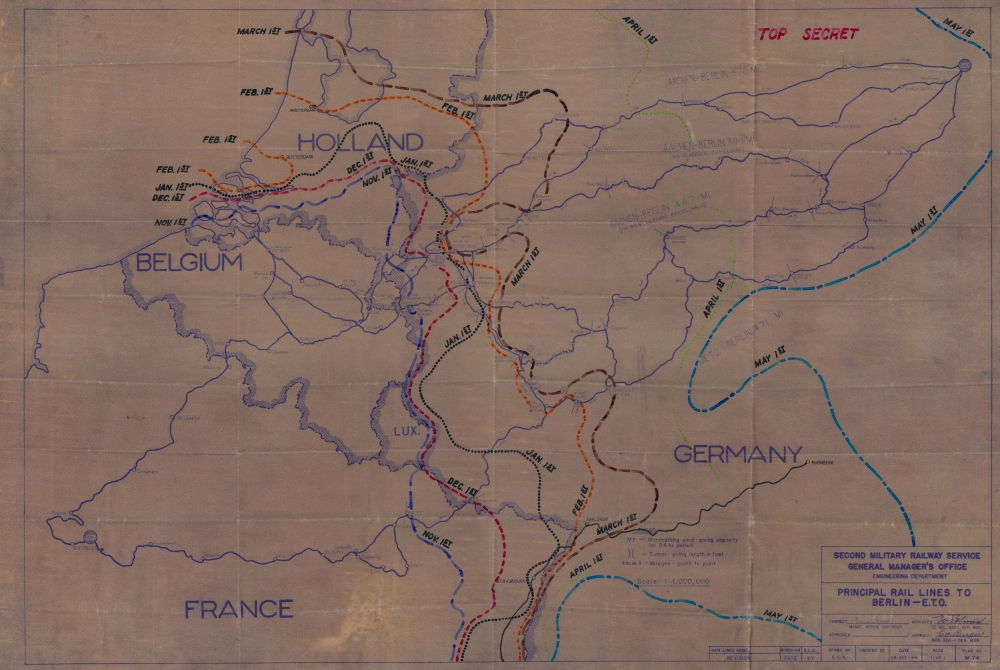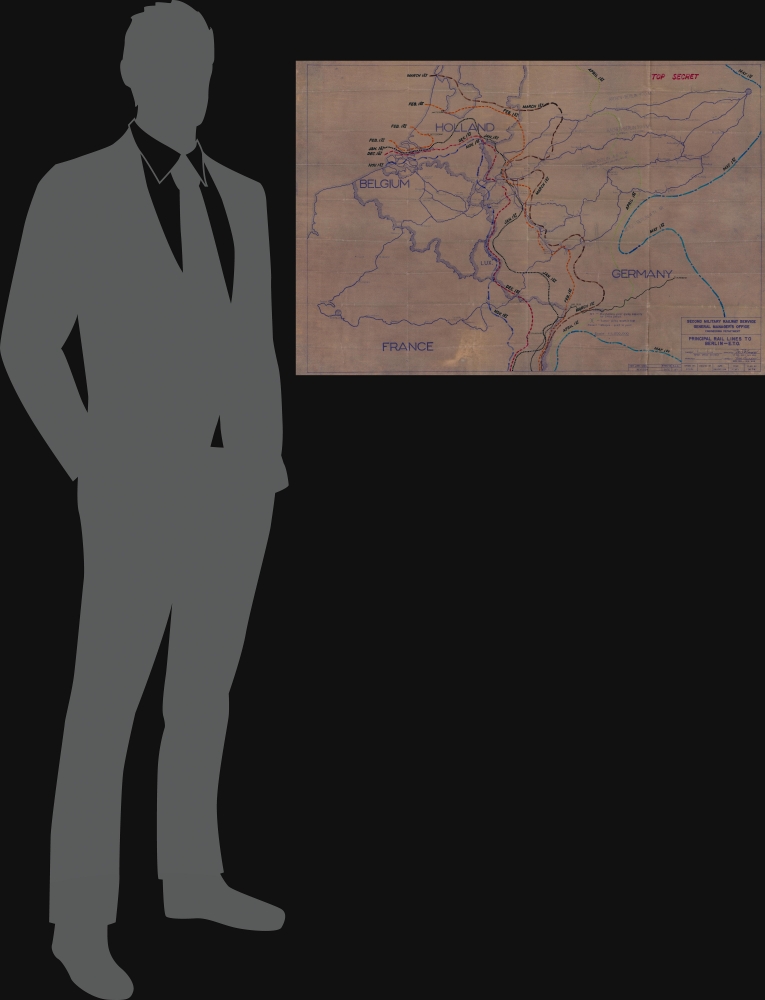This item has been sold, but you can get on the Waitlist to be notified if another example becomes available, or purchase a digital scan.
1944 World War II Second Military Railway Service Map of Western Europe
RailLinesBerlin-militaryrailway-1944$625.00

Title
Principal Rail Lines to Berlin - E.T.O.
1944 (dated) 23 x 34 in (58.42 x 86.36 cm) 1 : 1000000
1944 (dated) 23 x 34 in (58.42 x 86.36 cm) 1 : 1000000
Description
A unique piece, this is a 1944 World War II (1939 - 1945) Second Military Railway Service railroad diazotype map of Europe with extensive predicative manuscript annotation relating to managing logistics behind the battle lines in the face of rapid frontline advancement. The fascinating annotation predicts the Allied advance across Europe in stages from November 1944 through May 1945. The map thus underscores a critical but often overlooked aspect of World War II - logistics.
A Closer Look
Depicting from Paris east to Berlin, this diazotyped map illustrates borders between countries and railroad lines. Major cities along the lines are labeled in France, Belgium, Holland, and Germany. As the lines get closer to the battle front, marshalling yards (and their capacities over a 24-hour period) are noted. Distances between cities appear as well, although not between all. Within Germany, tunnels are marked with, in some cases, their lengths.Manuscript Battle Lines
Manuscript battle lines progress across the map predict Allied progress from November 1944 through May 1945. The lines are not 100% accurate. For example, Berlin is shown as the May 1st line, but American forces never entered the city. Likewise, Saarbruken wasn't occupied until March 15, but the Dec. 1 line on this map goes through the city. These lines are thus predictive and used to plan logistics in anticipation of successful advances, rather than content that was added retroactively.The Second Military Railway Service
The Second Military Railway Service (MRS) was the unit created to operate the Western European railway network behind the battle lines to ferry supplies from ports to depots. Activated at Camp Plauche, Louisiana, on December 28, 1943, the Second Military Railway Service left for England on February 27, 1944, only to have the troop ship they were on turn back and dock in Newfoundland for repairs. They finally arrived in Scotland on March 20, 1944, and took the train south to a camp at Little Heath, a London suburb. The first elements of the Service departed England for France on June 16, 1944, ten days after D-Day. The rest of the unit was in France by end of the first week of July. The Service's first task was to establish rail traffic from Cherbourg (their first headquarters and the first deep water port open to the Allies) south to Le Mans. The first train arrived in Le Mans on August 15, and in Paris on August 30. As Second MRS continued to expand across Europe, their task ballooned. Between February and V-E Day (May 8, 1945), the Second MRS moved twenty thousand trains and transported over 9,000,000 tons of supplies.Diazo Print or Whiteprint
The diazo print (whiteprint or diazo for short) is a photo reproductive technique best understood as a reverse cyanotype or blueprint. The process yields distinctive blue lines on white paper. Like cyanotypes, the diazo process gained popularity in architecture circles, where it was a simple and effective way to duplicate documents in the field. The earliest diazotypes appeared around 1880 and were adopted for military and field cartographic use from about 1895. The diazo process was commercialized in 1923, when the German firm, Kalle and Company, developed Ozalid, a patented diazo paper that made diazotyping even easier. By the 1950s, it supplemented cyanotypes as the reprographic technique of choice for technical drawings.Publication History and Census
This map was created and diazotyped by the Second Military Railway Service General Manager's Office on October 26, 1944, and was updated to November 6, 1944. This is the only known surviving example. The manuscript notations illustrating the moving battlefront make this piece a unique historical artifact from a critical, but often overlooked, aspect of the European Theater of Operations during World War II.Condition
Very good. Wear along original fold lines. Manuscript annotations marking Allied progress in western Europe from November 1944 through May 1945.




